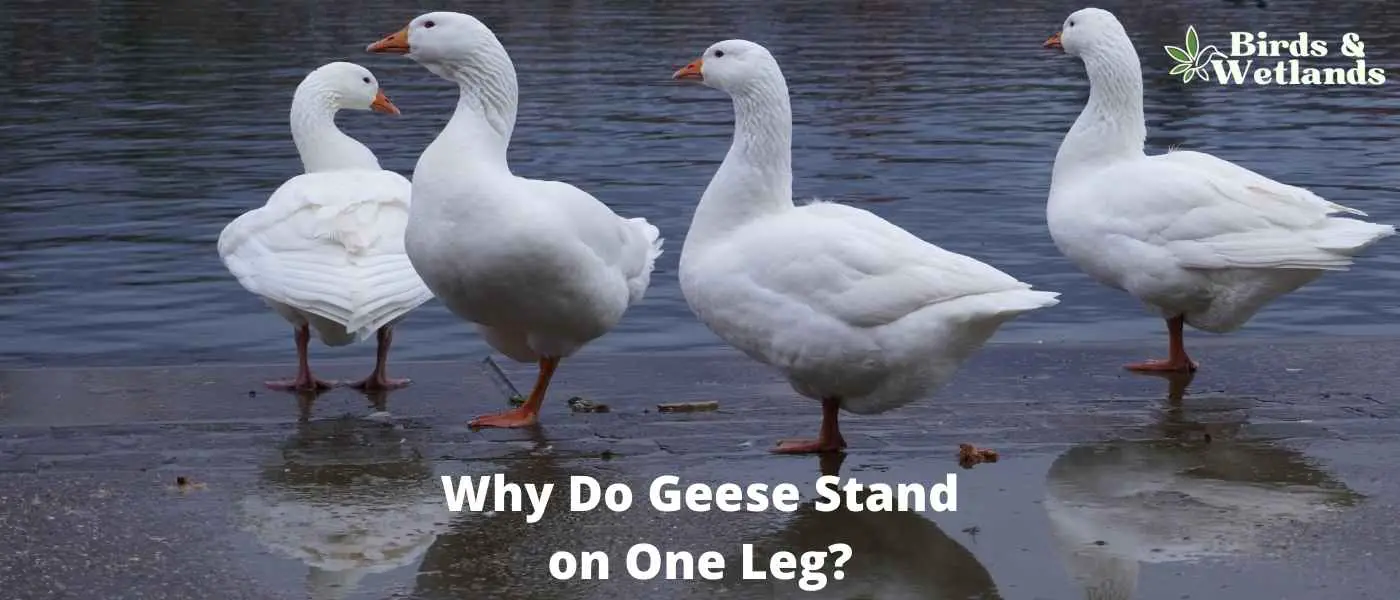It’s not because they’re lazy! In fact, there are a number of reasons why these birds might stand on one foot for extended periods of time.
One of the most likely explanations has to do with thermoregulation of their body temperature. Standing on one leg allows the goose to keep more heat close to the body, which is beneficial in colder weather.
Additionally, standing on one leg frees up the other leg, which the bird can use to tuck into its feathers for added warmth. By keeping one leg elevated, blood flow to the foot is reduced, which also helps conserve heat.
Geese, like many other birds, stand on one leg to conserve heat and regulate their body temperature
This behavior allows them to tuck the other leg into their feathers for added warmth and reduce blood flow to the foot, which helps to conserve heat
Standing on one leg also allows geese to balance themselves and may help to relieve fatigue in the other leg
This behavior is common in birds and helps them to survive in their environments
Why Do Birds Raise One Leg?
It’s not uncommon to see geese stand on one leg at the pond, or shorebirds balanced on just one leg at the beach. On rare occasions, you can see dark-eyed juncos or sandpipers travel short distances, hopping on one leg.
The answer lies in the rete mirabile, a network of arteries and veins found in the legs of many birds. This network minimizes heat loss by allowing the arteries that transport warm blood into the birds’ legs lie in contact with the veins that return colder blood to the bird’s heart.
In a way, the warm arteries heat the cooler veins. With one foot tucked up, a bird reduces half the amount of heat lost through its unfeathered limbs.
In addition to the rete mirabile, many birds also have special feathers that help to insulate their bodies and keep them warm. By raising one leg instead of standing on two legs, birds can tuck these feathers close to their bodies and manage heat loss more effectively.
In the summer, birds are generally more active and may spend more time standing on one leg than in other seasons. This could lead to fatigue on one leg, and raising the other leg may help to relieve this fatigue.
When you see birds stand on one leg, it may be their way to balance themselves. Birds are constantly shifting their weight, and raising one leg may help the bird to keep its balance.
Do Geese’ Feet Get Cold?
Yes, the bird’s feet can get pretty cold because they are closer to the environmental temperature, especially during the winter’s cold.
Even though they have a layer of feathers to protect them, sometimes the cold is too much. In these cases, they will tuck one leg into their feathers to warm them up. This allows them to stand on the other foot and keep warm.
Do Geese Sleep on One Leg?
Depending on the bird species, they may sleep standing up. Long-legged herons, short-legged ducks, and geese often roost in a peg-legged stance or standing on one leg while keeping the other leg tucked into their body feathers for warmth.
This position helps them to conserve body heat and stay warm during colder weather. Geese are also known to sleep with their heads and beaks tucked under shoulder feathers for extra warmth.
How Do Geese Regulate Their Body Temperature in the Winter?
Birds, including geese, are endothermic. These birds increase their energy expenditure in colder weather to maintain a constant body temperature.
Moreover, Geese reduce their heart rate and tolerate a lower core body temperature. This ability allows them to save energy and stay warm in the winter. This is called winter hypometabolism.
The Take-Away on Why Do Birds Stand on One Leg
Even though they’re covered in fluffy warm feathers, Canada Geese and other birds stand on one leg to retain as much heat as possible and conserve energy.
Basically, the arteries that transport blood into the legs of the bird come in contact with its veins.
During the winter, geese stand on one leg to keep their body warm. In the summer, they may stand on one leg to rest and prevent fatigue on the other leg.
FAQs on Geese and Other Birds Standing on One Leg
Do Birds Ever Get Tired of Standing?
Like people, birds can get tired from standing for long periods. They may exhibit signs of fatigue, such as irritability or restlessness. If a bird is kept in an enclosure where it cannot move around much, it is essential to provide perches of different sizes and textures to help relieve boredom and foot strain. Domestic geese should have a grass area where they can sit and rest their legs.
Can Geese Survive With a Broken Leg?
The answer is yes, they can. While most birds that experience limb loss do not survive, there are some that are able to adapt and compensate for the missing leg. The key is to catch the injury early and give the bird the best possible care (learn how to catch and hold a duck to treat injuries). With proper treatment, a one-legged Canada goose can live a long and happy life.


